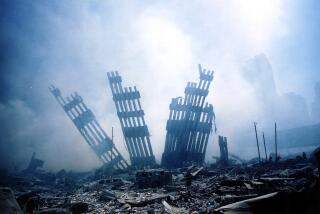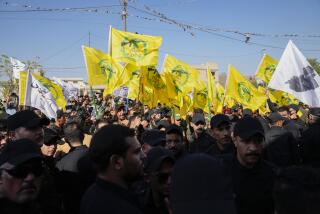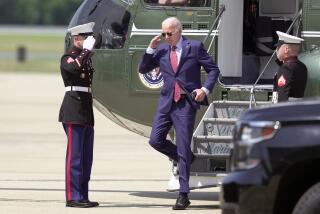Untested in Modern Combat : Saudi Military Competent but Facing Stiff Challenge
WASHINGTON — Early last month, Iranian warships and helicopters, in an escalation of their long-running campaign of harassment of merchant ships passing through the Strait of Hormuz, began menacing Saudi Arabian ships that they usually had left alone.
After enduring the assaults for about two weeks, the Saudis sent their F-15 warplanes to patrol the Persian Gulf, ready to retaliate for any Iranian attack on ships flying the desert kingdom’s green and white flag. The Iranians abruptly halted the harassment, not only of Saudi ships but of others as well.
“It seems that every time the Saudis show their resolve, the Iranians back off,” a State Department official said. But he added that it is still far too early to be sure of Iran’s intentions.
Despite such occasional shows of force, however, the Saudi military remains largely untested in modern combat. U.S. experts say that the kingdom’s forces are generally regarded as competent and professional but that they face daunting difficulties in preparing for the defense of a rich and underpopulated nation surrounded by potential enemies in an increasingly volatile Arab world.
The capabilities of the Saudi armed forces have been largely overlooked in the raging political debate over President Reagan’s plan to sell the Riyadh government $265 million worth of air-to-air and air-to-ship missiles. A vote scheduled for today in the Senate is expected to settle the issue one way or the other.
Even if approved, that package itself is too small to have a major impact on the regional military balance. However, the vote has taken on tremendous symbolic importance.
If this sale goes through, the anti-Saudi coalition in Congress has indicated that it will try to block delivery of five AWACS aircraft that the Riyadh government bought for $8.5 billion in 1981. Deliveries are scheduled to begin this summer. The State Department official said the AWACS (airborne warning and control system) planes are absolutely vital to Saudi Arabia’s defenses.
“This package is not all that important, per se,” William B. Quandt, a former National Security Council specialist on the Middle East, said of the missile sale. “It is a question of what happens from here on out. Will this be the last transaction of this sort? What happens with AWACS? Where will the Saudis go for weapons the next time? Presumably they do not want to go through this very many more times.”
Saudi Arabia has only about 62,500 men under arms, spread thinly over 830,000 square miles of mostly desert terrain covering the world’s largest known oil reserves. The military is drawn from a population of under 12 million, of which fewer than 2 million can read and write.
Air Force at Center
For the last 15 years or so, Saudi Arabia has built its defenses around its air force because that is the only military arm mobile enough to patrol the kingdom--a land area almost as large as the United States east of the Mississippi River--and, at the same time, protect Saudi interests on the troubled waters of the gulf.
“They are pretty good,” the State Department official said when asked about the quality of the Saudi forces. “More than most of the other (Third World countries), they have had the financial resources to continue training. But it is hard to make a good assessment until they get into a combat situation.”
“The Saudi air force is good, by Third World standards,” Quandt said. “You could put a Saudi pilot up against a Pakistani or a Jordanian, and that is pretty good. The equipment is good and fairly well maintained.”
Treated as Elite
But Quandt and the State Department official, who asked not to be further identified, agreed that the quality of the Saudi military falls off after the air force, which has been treated as the elite service.
The army is small and split into two often-competing organizations, each under the patronage of a separate prince. And with a navy that is tiny, untested and not highly regarded, the Saudis would have to depend on the air force to handle emergencies in the gulf, the official said.
Under an American doctrine, first pronounced in 1980 by President Jimmy Carter and reaffirmed by Reagan, the United States is pledged to resist--with its own military forces, if necessary--any disruption in the flow of oil from the Persian Gulf region. Still, U.S. military contingency plans count on Saudi Arabia to defend itself against all threats short of an overt Soviet attack.
‘Almost Unreachable’
“Our policy is to assist the defense forces of the region to do the job rather than trying to police it ourselves,” the State Department official said. “The Carter doctrine is almost an unreachable objective--certainly unreachable without the support of the states in the region.”
But for the moment, at least, U.S. policy on Saudi Arabia is focused on today’s Senate vote on Reagan’s plan to sell the Saudis 1,666 Sidewinder air-to-air missiles worth $158 million and 100 Harpoon air-to-ship missiles worth $107 million. In an effort to defuse some of the strong opposition to the package, the President agreed to remove from the package 200 shoulder-fired Stinger anti-aircraft missiles worth $89 million.
The Senate and House voted earlier to block the sale, but Reagan vetoed the legislation, setting the stage for the Senate attempt to override the veto. If Reagan can muster 34 votes--just over one-third of the Senate--the sale can go through. But, if the veto is upset in the Senate, the House is expected to follow suit, blocking the transaction.
Tired of Political Battles
And, regardless of the outcome of this parliamentary skirmish, there are growing indications that the Saudis have become weary of bruising political battles over weapons sales.
The Saudis earlier this year bought 40 British-made Tornado warplanes when congressional opposition made it unlikely that they could obtain their first choice of U.S.-made F-15s. It was the first major Saudi purchase from a non-American supplier.
The Saudi ambassador to Washington, Prince Bandar ibn Sultan, a former fighter pilot who played a key role in winning congressional approval of earlier weapons packages, has remained aloof from the Capitol Hill debate this time, presumably to avoid raising the stakes to such an extent that defeat would spell humiliation.
The Saudi government in Riyadh and its embassy in Washington refused to discuss the nation’s military posture before the Senate vote. However, U.S. sources agreed to provide estimates of Saudi military strength and of the military threat faced by the kingdom.
Top-of-the-Line Planes
The Saudi air force consists of about 14,000 men, equipped with 224 warplanes, about half of them top-of-the-line F-15s and Tornados and the other half older and lighter F-5s.
The army has about 35,000 troops organized into three armor brigades, three mechanized infantry brigades, one light infantry brigade and one airborne brigade. The navy has about 3,500 personnel operating four frigates, four corvettes and a few light patrol boats.
The army, navy and air force are controlled by the Ministry of Defense under Prince Sultan ibn Abdulaziz, a brother and close political ally of King Fahd. But the kingdom also has a 10,000-member national guard that is, in effect, a separate army. The national guard is commanded by Crown Prince Abdullah, another brother and probably the member of the royal family with the closest ties to Syria.
“Traditionally, there has been a policy of the national guard and the regular army somewhat offsetting each other,” Quandt said. “They are not very well integrated, and presumably that is by design. That is something that Americans often find exasperating, but the Saudis have succeeded where many other Middle Eastern nations have failed in keeping the military from making coups.”
Facing External Threats
Having attained relative internal security, the Saudis still are faced with external threats from such potential enemies as Israel, Iran, Iraq, South Yemen, Ethiopia and Libya.
A joint Pentagon-State Department assessment determined that the Saudis probably could defend themselves for the rest of this decade. But that assumes the kingdom will not have to fight more than one of its neighbors at a time and will not have to fight Israel--by far the strongest single state in the Middle East--at all.
But the State Department official said it is far less certain that the Saudis could handle potential threats in the 1990s, especially if the Iran-Iraq War finally comes to an end.
On paper, Iraq is the strongest of Saudi Arabia’s potential foes. Iraq’s Soviet-equipped air force has more than 500 combat planes, more than twice that of the Saudi force. Relations between Riyadh and Baghdad are cordial at present, but the two nations have been foes before and could be again.
Iran Most Dangerous
U.S. officials believe that Iran is the most dangerous of Saudi Arabia’s potential adversaries. In such a conflict, the Saudis would have clear air superiority because the American warplanes that Iran bought during the reign of Shah Mohammed Reza Pahlavi have mostly been grounded because of poor maintenance and a shortage of spare parts. U.S. officials estimate that Iran has no more than 80 serviceable aircraft.
But, considering Iran’s far larger population, the Iranian army is considered much stronger than the Saudi army.
Opponents of the arms sale package argue that Saudi Arabia never will be strong enough to blunt a full-scale attack but that arms supplied to the Riyadh regime might be transferred to the Palestine Liberation Organization or other forces arrayed against Israel.
More to Read
Sign up for Essential California
The most important California stories and recommendations in your inbox every morning.
You may occasionally receive promotional content from the Los Angeles Times.










